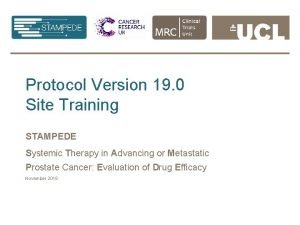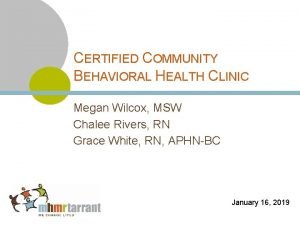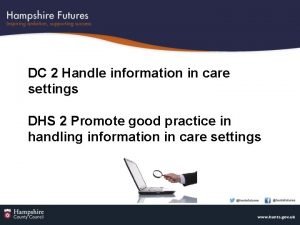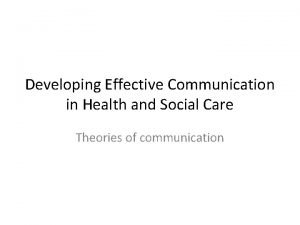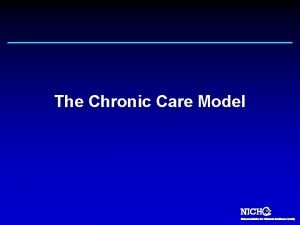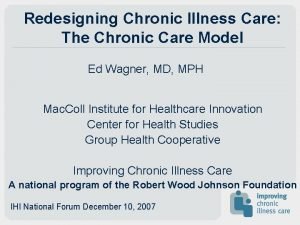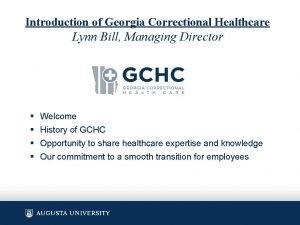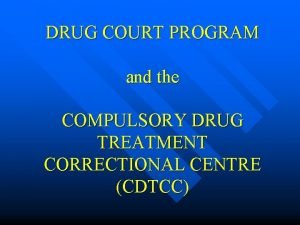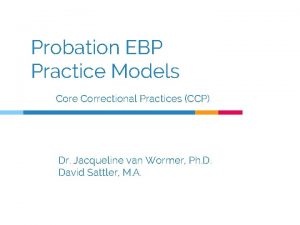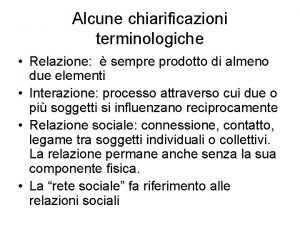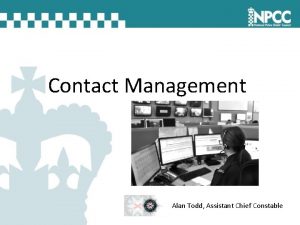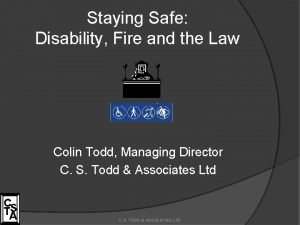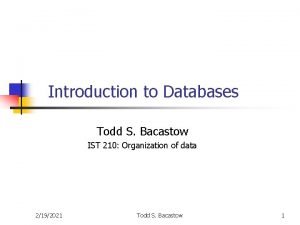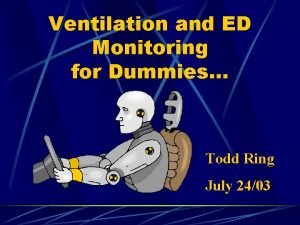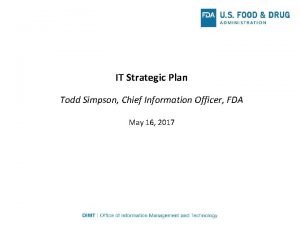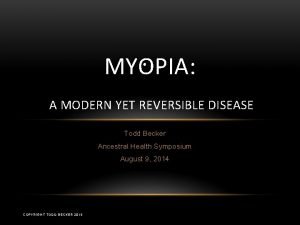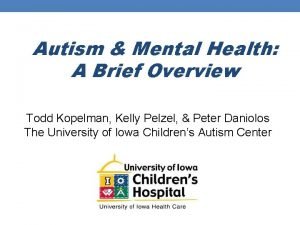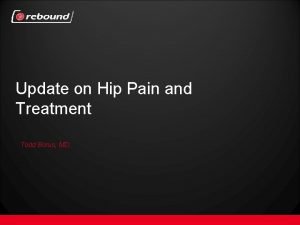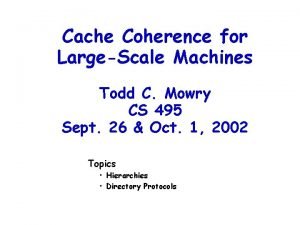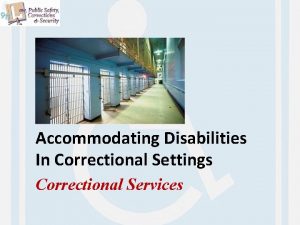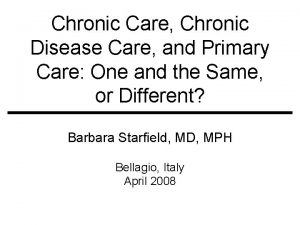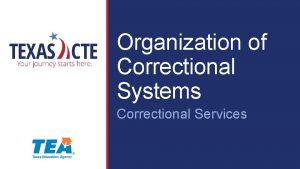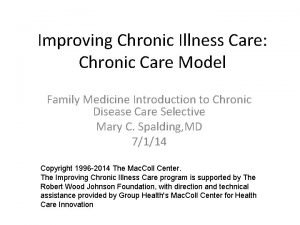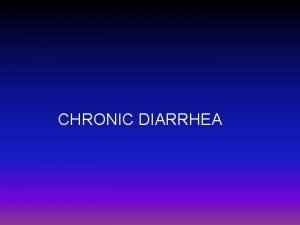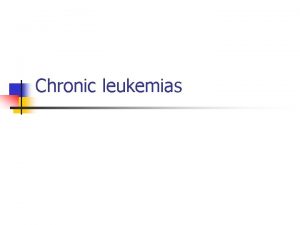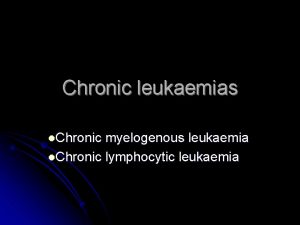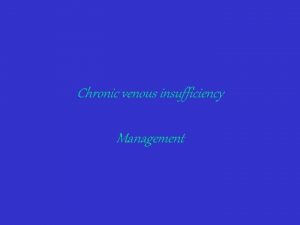Chronic Care In Correctional Settings Todd R Wilcox











































































- Slides: 75

Chronic Care In Correctional Settings

Todd R. Wilcox, MD, MBA, CCHP Medical Director Salt Lake County Jail System 801 -424 -1500 trwilcox@wellcon. net Mark Ellsworth, RN, BSN, CCHP Health Authority Salt Lake County Jail System 801 -743 -5542 mellsworth@slco. org

Slides and handouts available for download at: www. wellcon. n

Changing Times Correctional Health is the new Public Health Increased inmate populations Increased disease acuity Changing of disease spectrum Decreased funding to public health Deinstitutionalization of patients Constitutionally mandated care

Nature of the Problem Inmate population continues to grow 11. 5 million inmates released into the community every year 500, 000 correctional employees at risk for communicable diseases Untreated diseases pose serious financial burden on

Magnitude of the Problem Releases from custody per year: 1, 400, 000 inmates with Hepatitis C 465, 000 inmates with STD’s 12, 000 inmates with active TB 74, 000 inmates with diabetes 283, 000 inmates with hypertension

Magnitude of the Problem

Cost effective vs. cost savings Interventi Cost Condition effective Yes if > Syphilis screening 1% Gonorrhe screening yes a Chlamydi screening yes a counsel/t HIV yes est TB Hyperten on screening yes savings Yes if > 1% women, yes yes**

Correctional Health Impacts on Public Health “Captive” audience Identifies highest risk, hardest to find patients High volume screening Guaranteed followup Discharge planning Potential for greatly improved community health

Making It Work For Your Facility Acquiring Resources Right mindset Public Relations--you are doing public health Data acquisition Electronic Medical Record Pitch to electeds, funding bodies

Chronic Disease Long term impact on health Benefits from frequent MD visits Most common diseases hypertensio asthma n HIV/AIDS diabetes epilepsy schizophren ia TB chlamydia/g onorrhea Syphilis

Why Manage Chronic Diseases? Chronic Disease Problems Acute Diabetes Coma, diabetic ketoacidosis, sepsis Epilepsy Seizures, status epilepticus, injuries Schizophrenia Acute psychosis, harm to self and others Asthma Acute asthma attacks, death Hypertension hypertensive crisis, stroke, heart attack HIV/AIDS pneumonia, TB

Why Manage Chronic Disease? Poorly managed chronic disease leads to many emergency runs, man-downs, ambulance runs, ER visits, and hospital admissions Reduces your costs Reduces your litigation Reduces risk to staff and other prisoners Makes institutions run smoother

How To Manage Chronic Diseases Staff training Appropriate licensure Screening!!!! Close followup in first 72 hours 14 day assessments on day 2 quarantine unit

How to Manage Chronic Diseases On-site diagnostic testing CLIA-certified lab for CBC, electrolytes, diagnostic blood levels, and PT/INR Dedicated chronic care paths and clinics Rapid availability of appropriate medications

How to Manage Chronic Diseases Partnership with Corrections Training Special Needs Communication The Pink Card--travels with inmate locator Special Needs Communication Reference Book--instructs the officers in the “down and dirty” of what they need to know about chronic diseases Responsiveness to officer concerns

Salt Lake County On-site Lab Tests




POC Menu CBC Electrolytes PT/INR Urinalysis Thyroid function tests Diagnostic drug levels Hg. A 1 C PSA Cardiac isoenzymes Hepatitis C

Current Cost Analysis Lab CBC PT/INR Electrolytes Current $ 36, 210 2584 56, 447 On-site $ 5, 298 2380 29, 230 Savings 30, 912 204 27, 217 Drug levels 22, 500 5200 17, 300 TSH Hep C PSA Cardiacs Hg. A 1 C 56, 100 13, 700 5, 617 590 11, 447 10, 300 6030 1852 (8780) 6474 45, 800 7, 670 3, 765 (8, 190) 4, 980

Cost Savings Diagnosis Current $ Chest pain Abdominal pain Seizure Infection Cellulitis Totals 697, 000 Estimated Savings 196, 671 289, 360 130, 678 120, 106 79, 290 369, 654 1, 555, 410 46, 101 19, 882 92, 413 485, 745

Capital Costs to Convert to POC Instrument CBC I-Stat DCA 2000 Axsym Centrifuge Cost 21, 000 5, 600 0. 00 1, 600 Total 28, 200

EMR

Type 1 Diabetes Insulin deficiency Goals of therapy Glucose control Avoidance of disease complications Therapy based on checking blood sugars minimum frequency 3 x a day all diabetics should have a sliding scale in place

Type 2 Diabetes Resistance to insulin Treatment Goals Weight loss Glucose control Avoidance of disease complications

Correctional barriers to care in diabetics Medical Access to patient Availability of healthcare resources Exercise Diet Commissary access

Asthma Defined as reversible airway obstruction Most are mild, the severe ones are really sick Goals of therapy: decrease frequency of attacks decrease medication use decrease ER visits prevent progression of disease

Correctional barriers to care in asthmatics Smoke free environments Inadequate ventilation Environmental triggers Keep on person inhalers

Epilepsy Recurrent seizures due to a chronic underlying process Important to separate from other causes of seizures Treatment goals Decrease medications without increasing seizures

Epilepsy Recurrent seizures due to a chronic underlying process Eliminates single seizures, seizures due to correctable or avoidable circumstances Prevalence is 6. 6 per 1000 in US

Seizures--Correctional Style Seizures frequently witnessed Designed a nursing assessment form to “capture the evidence” Historian Allergies Description Contributing of events Factors Medical Medications history GCS Neuro Exam Pregnancy Decision Making Treatment Disposition

Seizures--Correctional Style Withdrawal accounts for most seizures Usually 1 -6 seizures Usually tonic-clonic, rarely focal or status Majority occur within 48 hours Key to managing these patients is a good withdrawal assessment program

Alcoholics Just Seize 308 Patients, 294 Controls 60% of seizures were random events Frequency of seizures increased with increasing ETOH: 3 x normal if 1/2 pint per day 8 x normal if 1 pint / day 20 x normal if 1 quart / day

Seizure vs. Syncope Feature Seizure Syncope Stress, hypotension, cardiac Diaphoresis, tunneling vision Precip Factors None Premonition None / aura Posture Variable Erect Immediate Gradual Minutes to hours < 5 minutes Biting tongue Sometimes, specific if lateral Rare Incontinence Sometimes Rare Transition to unconscious Disorientation after

Tonic. Clonic Valproic Acid Lamotrigin First-Line Partial Absence Carbamaz Ethosuxim epine ide Phenytoin Valproic Acid Lamotrigin e Phenytoin Gabapenti Lamotrigi Carbamaz n ne epine Topiramat Clonazepa Topiramat e m Seconde Tiagabine

The Old Medications Interactio Systemic ns Med 1/2 Life Dilantin 24 hrs Gums Lymph Many--INH, sulfa, folate 10 -17 hrs Aplastic anemia Leukopenia Hepatotoxicity Many-cimetidine, INH, erythromycin 15 hrs Hepatoxicity Thrombocytope nia GI irritation Enzymeinducing Rash valproic acid, phenytoin Carbamazepine Valproic Acid Phenobarbital 90 hrs

Med Felbamate The New Medications Common Name Felbatol Gabapentin Neurontin Lamotrigine Lamictil Topiramate Topamax Tiagabine Gabatril Levetiracetam Keppra Oxcarbazepine Trileptal Comments Black box warning for aplastic anemia, hepatotoxicity 80% of RX’s are off label, Adjunctive only, No drug interactions, huge safety margin Monotherapy, skin rash, titration to therapeutic is 8 -12 weeks Adjunctive, minimal side effects, titration 8 -12 weeks Adjunctive, novel mechanism of action, minimal interactions and side effects Adjunctive, highest safety margin of all seizure drugs, no interactions, rapid titration Monotherapy, hyponatremia, similar to carbemazepine with fewer side effects

New vs. Old No advantage in efficacy Broader spectrum of activity Fewer adverse effects Fewer drug interactions More expensive No need to monitor serum levels or CBC/LFT (except felbamate)

Epilepsy Barriers to Care Secondary Gain Significant overlap withdrawal seizures Physical plant limitations (i. e. , bottom bunks)

HIV HIV+--infected with virus AIDS--clinical syndrome where immune system is significantly compromised Goals of treatment reduce viral load maintain immune system maintain weight minimize medication complications minimize opportunistic infections

HIV Barriers to Care stigma confidentiality cost of care maintaining continuity of care access to HIV specialists

Schizophrenia Positive Negative Symptoms Hallucinations Blunted affect Paranoia Social withdrawal Delusions Apathy Hostility Poor hygiene Combativeness Poor judgment Grandiosity Poor / absent speech

Schizophrenia Barriers to Care Increasing patient loads in corrections Inadequate staffing Inadequate officer training Inadequate physical plant Inappropriate lockdown Housing complications--heat, predation Fiscal issues--new psychotropics

Receptors vs. Effects Receptor Adverse Effect Dopamine EPS, elevated prolactin Serotonin Anxiety, insomnia, appetite Histaminergic Drowsiness, somnolence alpha-adrenergic orthostatic hypotension Muscarinic anticholinergic effects

Metabolic Weight gain and Type II Complications Diabetes Associated with atypical antipsychotics Not caused by any single atypical antipsychotic Schizophrenia has been found to be an independent risk factor for Type II Diabetes Family history, ethnicity, obesity are stronger causal agents than the medication itself

Metabolic Assessment Complications Recommendations Personal / family history of obesity / DM / dyslipidemia / hypertension / CV disease Weight and height (BMI) Waist circumference Blood pressure Fasting plasma glucose Fasting lipid profile Weight (4, 8, 12 wks) Fasting glucose, lipids and BP at 3 m and annually thereafter

Metabolic Syndrome Risk Factor Defining Level > 40 inches male; > 35 inches Abdominal Obesity female Fasting > 150 mg/dl or in drug treatment for increased TG Triglycerides Fasting HDL Men < 40 mg/dl and. Women < 50 mg/dl Or currently in drug treatment for HDL Blood Pressure > 130 systolic / > 85 diastolic Or currently treated for HTN Fasting Glucose > 100 mg/dl

Metabolic Syndrome 24% of US adults have MS Schizophrenics--prevalance of MS is double the general population In CATIE (Clinical Antipsychotic Trials of Intervention Effectivness), males were 85% more likely to have MS than their control cohort; Females were 137% more likely than control

Implications of Metabolic Syndrome New Chronic Disease entity Psychiatrists have to screen / monitor Should develop consent forms / entry criteria Should develop chronic care pathways Should consult medical for treatment options

Lithium Lightest metal known Used to be a component of 7 up Used in early 1900’s as table salt 1970 --recognized for bipolar disorder Excreted via kidney, dependent on GFR

Acute Lithium GI upset Toxicity Diarrhea Delayed neurologic manifestations Leukocytosis Hyperreflexia, clonus Choreoathetoid movements Fine tremor

Chronic Lithium Toxicity Myocarditis Dermatitis, ulcers Diabetes insipidus Aplastic anemia Parkinson’s disease Hypothyroidism

Lithium Testing Electrolytes Renal function Serum lithium Serum osmolarity CBC TSH EKG

Lithium in Corrections Great medication Should always be given Direct. Observe Small therapeutic window Assess lithium levels, additional labs to monitor

BP Measurement Technique Patient is seated Cuff at heart level Proper cuff size Bladder should encircle 80% Too big not a problem Tubing pointing up Two measurements 30 min apart Prefer readings in both arms Automated BP?

BP Measurement Falsely Increased BP Singing, talking Caffeine, tobacco, Et. OH “White coat” (increase up to 20/10) Pain / “reactive” Cuff too small Rapid deflation (falsely increased DBP)

BP Measurement Falsely decreased BP Excessive bell pressure Rapid deflation (falsely decreased SBP)

Definitions DBP SBP Normal < 80 < 120 Prehypertension 80 - 89 120 - 139 Stage 1 HTN 90 - 99 140 - 159 Stage 2 HTN ≥ 100 ≥ 160 JNC = Joint National Committee on Prevention, Detection, Evaluation, and Treatment of High Blood Pressure. NHBPEPCC. Available at: www. nhlbi. nih. gov/guidelines/hypertension/express. pdf.

Autoregulation of Cerebral Blood Flow C B F MAP

Patient Outcomes

Diabetics and HTN

Patient Outcomes

Achieving Goals

Identifiable causes of HTN Sleep apnea Drug use Chronic kidney disease Primary aldosteronism Renovascular disease Chronic steroid therapy / Cushing’s Pheochromocytoma Coarctation of the aorta Thyroid or parathyroid disease

Physical Exam Measure BP Examine fundi Calculate BMI Auscultate for bruits Palpate thyroid Examine heart/lungs, visceral organs Check for peripheral edema / pulses Assess neurological status UA / Chem profile / EKG


Chronic HTN Recommendations (from JNC 7) Don’t ignore systolic hypertension Most older patients become hypertensive Prehypertension begets hypertension Use thiazides Most patients need more than 1 medication For higher pressures, start with 2 drugs Work with patient to build compliance

Compelling Indications

Medication Choice

Medication Combinations

Summary All healthcare is expensive, bad healthcare is more expensive Chronic care helps you minimize risk Chronic care screening helps protect your officers Correctional Health is the new Public Health--go fight for resources

Reference Material www. ncchc. org chronic care guidelines Health Status of Soon-To-Be. Released Inmates Conferences www. cdc. gov Care guidelines for many diseases

Slides and handouts available for download at: www. wellcon. n
 Dr wilcox orthopedic
Dr wilcox orthopedic Arlen wilcox
Arlen wilcox Professor ian wilcox
Professor ian wilcox Eric wilcox rit
Eric wilcox rit Escala de autocontrol de kendall y wilcox
Escala de autocontrol de kendall y wilcox Maureen wilcox lottery
Maureen wilcox lottery Wilcox behavioral health clinic
Wilcox behavioral health clinic Handling information in care settings
Handling information in care settings Argyle's communication cycle
Argyle's communication cycle Flinders model of chronic care self-management
Flinders model of chronic care self-management Chronic care solutions
Chronic care solutions Chronic care model wagner
Chronic care model wagner Chronic care
Chronic care Chronic care model definition
Chronic care model definition Improving chronic illness care model
Improving chronic illness care model Nursing care plan for acute pancreatitis
Nursing care plan for acute pancreatitis Chronic care solutions
Chronic care solutions Wagner chronic care model 1998
Wagner chronic care model 1998 Tertiary level of care
Tertiary level of care Leadership styles in correctional facilities
Leadership styles in correctional facilities University college of norwegian correctional service
University college of norwegian correctional service Office of correctional education
Office of correctional education Susan norton augusta university
Susan norton augusta university Correction in cjs
Correction in cjs Roles and functions of the correctional system
Roles and functions of the correctional system Correctional funnel
Correctional funnel Correctional officer rank structure
Correctional officer rank structure Collins correctional facility
Collins correctional facility Department of correctional services strategic plan
Department of correctional services strategic plan Judicial inspectorate for correctional services
Judicial inspectorate for correctional services Office of the correctional investigator
Office of the correctional investigator Cdtcc
Cdtcc Sexual harassment cases in correctional centres
Sexual harassment cases in correctional centres National correctional consciousness week
National correctional consciousness week Core correctional practices examples
Core correctional practices examples Translate
Translate I spy creator
I spy creator Mappa di todd cos'è
Mappa di todd cos'è Petra todd
Petra todd List the steps in the paced decision-making process
List the steps in the paced decision-making process Richard watson todd
Richard watson todd Todd chavez usf
Todd chavez usf Todd j. martinez
Todd j. martinez Todd lantz
Todd lantz Todd simpson hhs
Todd simpson hhs David todd lee
David todd lee Todd williams body
Todd williams body Todd is trying to quit cheating
Todd is trying to quit cheating Richard watson todd
Richard watson todd Pam todd
Pam todd Todd clarke albuquerque
Todd clarke albuquerque Laxative
Laxative Todd humphreys ut austin
Todd humphreys ut austin Todd humphreys ut austin
Todd humphreys ut austin Todd humphreys
Todd humphreys Alan todd psni
Alan todd psni Colin todd fire
Colin todd fire Todd bacastow
Todd bacastow Todd j. martinez
Todd j. martinez Decomposition
Decomposition Todd ring
Todd ring Fda oimt
Fda oimt Isang sistema ng mga sagisag na binubuo ng mga tunog
Isang sistema ng mga sagisag na binubuo ng mga tunog Myopia a modern yet reversible disease
Myopia a modern yet reversible disease Todd kopelman
Todd kopelman Todd huffman oxford
Todd huffman oxford Normalization
Normalization Todd franzen
Todd franzen Todd humes
Todd humes Richard watson todd
Richard watson todd Scott sinde
Scott sinde Final sketch
Final sketch Dr todd borus
Dr todd borus Todd c. mowry
Todd c. mowry La storia di amanda
La storia di amanda Todd phillips house
Todd phillips house

